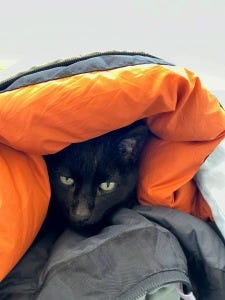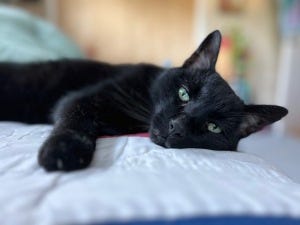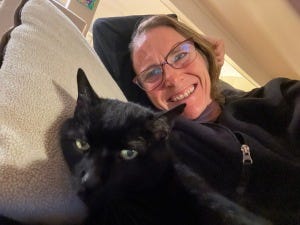Ode to Our Little Buddha
The vet said he wouldn’t make it to New Year’s Day. It was mid-December when he stopped eating. His kidneys were failing, she said. He was already quite far along. He also had hypothyroidism and a heart murmur. His little body was shutting down. He had a good run, at almost 16 years. We were given saline fluids and needles to administer 150ml under the scruff of his neck each night, too keep him comfy as long as we could. It doesn’t seem like a lot of fluid, but it took 4-5 minutes for that much fluid to flow under his skin. That’s a long time to hold still for a cat who likes to squirm. I asked him every time: Is this ok? Can we give you fluids? And he let us carry him to the kitchen table.
I also told him: If it’s time for you to leave us, let us know. You know how. We love you, and we understand. But somehow, he stayed until May. He defied the vet’s wildest expectations, even as he became emaciated and a bit wobbly. In the last few weeks, it was a feast if we could get him to eat more than a tablespoon of food a day. But he still reluctantly agreed to receive fluids. Sometimes he would moan if he had been sleeping. Sometimes he would cry if we accidentally pushed the needle too far and it went through two layers of skin. But he clearly still wanted to be here with us.
We couldn’t figure out how he was still with us, with almost no daily calorie intake and daily vomiting episodes. He was once a strapping 12 pound cat, with a powerful leap and clear intentions. In the end, he was probably down to 5 or 6 pounds. He felt like a kitten when I picked him up. But his intentions were still clear. In spite of his failing body, the fatigue, and (we’re assuming) nausea, he was still interested in life. There were a few things that he clearly loved: sunny windowsills, watching the crows, squirrels, and rabbits in the yard, and getting lots of pets. The feebler he became, the more love he wanted. And the more love he wanted to give.
He loved head-butting me each night as I stretched out on my yoga mat. I think he loved having one of his people come down to his level on the floor. Before his hips started to bother him, he would flop over on his side as I laid on the mat with him, and gaze lovingly at me. Then he’d walk circles around me bumping his head against my hips, my shoulder, my feet. His message was very clear: I love you.
I expected him to pull away from us when he was ready to go – to try to find a spot where he could be alone, to curl into a ball and hide in a corner, as a sign that it was time to move on to greener pastures. But that never happened. He never lost the desire for pets and attention. He never stopped wanting to sit in that sunny window.
When he passed out vomiting one night because he was so frail, we knew it was time to send him on his way. He was so tired. And he couldn’t seem to find a comfy position, with the pain in his hips and back that is common with kidney disease. But he still spent his last morning in a sunny window, watching the squirrels and the rabbits flit about the front yard.
This past spring, I participated in an online ‘retreat’ course offered by Thich Nhat Hanh’s monastery, Plum Village: Zen and the Art of Saving the Planet, titled after a book by the same name. Some of the ideas at the heart of Zen involve non-attachment – to outcomes, to material possessions, and even to life itself. The idea of non-attachment does not mean that you don’t care about life. The idea is to live fully in each moment, and learn to detach from what the next could bring.
At the heart of this is acceptance of the idea that we are of the nature to grow old, get sick and die, and that we will ultimately lose everything. While I know it sounds depressing when you first hear it, the idea is meant to be liberating. Accepting that is what allows you to live your life fully in the present. Living fully in the present is at the heart of how we begin to transform our world. As a civilization, we need to transform our need to do things, to buy things, to consume things in order to reduce our impact on the planet. It starts inside each one of us in feeling gratitude for what we have right here in this moment.
There is also the notion in Zen that once we die, our lives will continue on through the thoughts, words, and actions we engage in today. This is rooted in the concept that we are all deeply interconnected and that everything we do, think, or say affects everything else. I think of this as the ‘ripple effect’ that someone has in your life and in the world, even after they’re gone.
Accepting those truths about life and death is no easy task. At least, not for a human. I struggle to accept these things every day, as most of us do. But I think acceptance is natural in the kitty world. In those last few months, Guinness was like a little Zen master. Maybe he wasn’t aware he was dying. He just moved from one moment to the next, doing whatever he was able to do, taking in whatever he could.
He was our little Buddha, living fully in the present moment. And, after awhile, I started to see the lesson he was here to teach us in his final months about aging gracefully: Appreciate each breath, each stroke of hand against silky fur. Love those around you, whatever is happening to your body. Accept suffering as a price for life – the price for some rays of sunshine and cuddles with your people.
This post comes to you as a ripple — a ripple from the life of Guinness. A little wave of love that will prompt you to give your cat or dog or child or friend a little hug, an extra nudge. Take a deep breath and feel the life moving in and out of you. Enjoy the moment.








